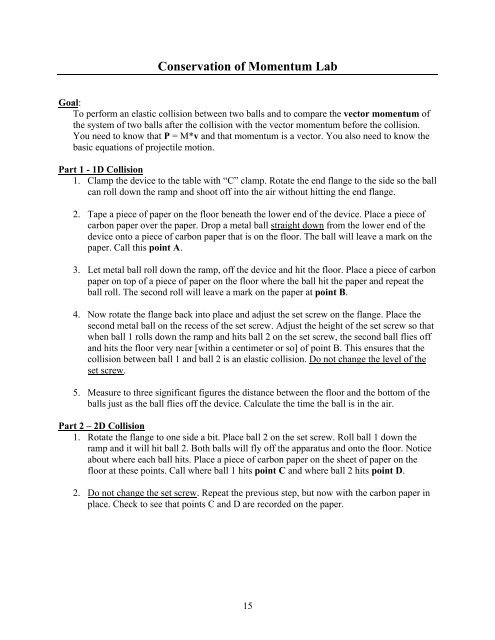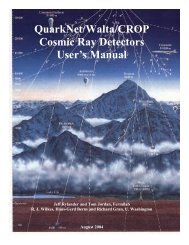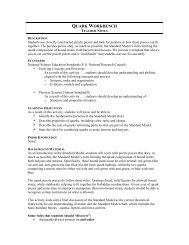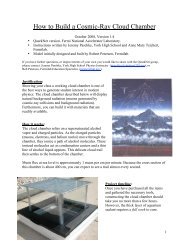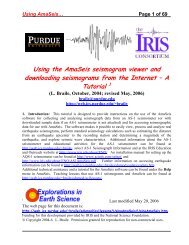Teaching Modern Physics - QuarkNet - Fermilab
Teaching Modern Physics - QuarkNet - Fermilab
Teaching Modern Physics - QuarkNet - Fermilab
Create successful ePaper yourself
Turn your PDF publications into a flip-book with our unique Google optimized e-Paper software.
Conservation of Momentum Lab<br />
Goal:<br />
To perform an elastic collision between two balls and to compare the vector momentum of<br />
the system of two balls after the collision with the vector momentum before the collision.<br />
You need to know that P = M*v and that momentum is a vector. You also need to know the<br />
basic equations of projectile motion.<br />
Part 1 - 1D Collision<br />
1. Clamp the device to the table with “C” clamp. Rotate the end flange to the side so the ball<br />
can roll down the ramp and shoot off into the air without hitting the end flange.<br />
2. Tape a piece of paper on the floor beneath the lower end of the device. Place a piece of<br />
carbon paper over the paper. Drop a metal ball straight down from the lower end of the<br />
device onto a piece of carbon paper that is on the floor. The ball will leave a mark on the<br />
paper. Call this point A.<br />
3. Let metal ball roll down the ramp, off the device and hit the floor. Place a piece of carbon<br />
paper on top of a piece of paper on the floor where the ball hit the paper and repeat the<br />
ball roll. The second roll will leave a mark on the paper at point B.<br />
4. Now rotate the flange back into place and adjust the set screw on the flange. Place the<br />
second metal ball on the recess of the set screw. Adjust the height of the set screw so that<br />
when ball 1 rolls down the ramp and hits ball 2 on the set screw, the second ball flies off<br />
and hits the floor very near [within a centimeter or so] of point B. This ensures that the<br />
collision between ball 1 and ball 2 is an elastic collision. Do not change the level of the<br />
set screw.<br />
5. Measure to three significant figures the distance between the floor and the bottom of the<br />
balls just as the ball flies off the device. Calculate the time the ball is in the air.<br />
Part 2 – 2D Collision<br />
1. Rotate the flange to one side a bit. Place ball 2 on the set screw. Roll ball 1 down the<br />
ramp and it will hit ball 2. Both balls will fly off the apparatus and onto the floor. Notice<br />
about where each ball hits. Place a piece of carbon paper on the sheet of paper on the<br />
floor at these points. Call where ball 1 hits point C and where ball 2 hits point D.<br />
2. Do not change the set screw. Repeat the previous step, but now with the carbon paper in<br />
place. Check to see that points C and D are recorded on the paper.<br />
15


